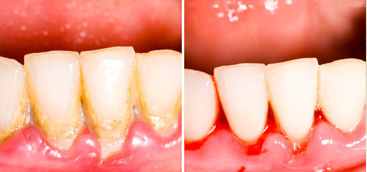ABSTRACT Objective: To ascertain in ƀ ammatory response through interleu- kin 1 ȕ presence and identify pathogenic microorganisms as pos- sible immunological and microbiological markers in diagnosis and treatment non-surgical periodontal in patients with gingivitis and moderate chronic periodontitis in a sample of Mexican population. Material and methods: In the present prospective cohort study, 18 patients with signs of gingivitis and 17 patients with moderate chronic periodontitis were selected. Samples of subgingival bio s lm and of crevicular gingival ƀ uid were collected.quanti s ed during the pre-treatment, post-treatment and maintenan- ce phases of the non- surgical periodontal treatment. Continuous variables were analyzed with the Student test, as well as categorical variables which were analyzed with the Turkey-Kramer test. For in- dependent groups the Pearson test was used. Results: Microbio- logical response variables showed that Porphyromonas gingivalis Prevotella intermedia, Fusobacterium nucleatum , Aggregatibacter actinomycetemcomitans significantly decreased in subjects with gingivitis, Porphyromonas gingivalis , Tannerella forsythia , Fuso- bacterium nucleatum , Aggregatibacter actinomycetemcomitans and Actinomyces ssp . decreased in cases. Biochemical response varia- bles showed signi s cant decrease in IL-1 ȕ concentration and total count in individuals with moderate chronic periodontitis in treatment maintenance phase. The same result applied to clinical response variables. Conclusions: There is a decrease in Interleukine 1 ȕ le- vels with decrease in micro ƀ ora. Interleukin 1 ȕ are sensitive markers for diagnosis of periodontal disease and assessment of its severity.
Key words: Non surgical periodontal treatment, Mexican population, gingivitis, moderate periodontitis.
Palabras clave:Tratamiento periodontal no quirúrgico, población mexicana, gingivitis, periodontitis crónica moderada.

INTRODUCTION
Within the scope of periodontal disease two entities are distinctive, and they possess clearly defined phenotypes: gingivitis (G) and periodontitis (P). These conditions can be clinically observed through chronic inflammatory processes, although in one case (periodontitis) this process evolves and destroys the periodontal attachment apparatus, and in the other case (gingivitis) the in ƀ ammatory process is maintained with no evolution towards destruction. 1-6 This inflammatory and immune response is determined by the presence of periodontal pathogens which are Gram negative anaerobic bacteria involved in the subgingival bio s lm 1,7-11 such as Porphyromonas gingivalis , Aggregatibacter actinomycetemcomitans (Ac), Tannerella forsythia (Tf), Prevotella intermedia (Pi), Fusobacterium nucleatum (Fn), Parvimonas micra (Pm), Campylobacter rectus (Cr) and Actinomyces ssp. 11-16 as well by biological modifying factors such as: systemic factors, genetic factors 17,18 and behavioral factors such as oral hygiene, smoking habits and stress. 19 In periodontal attachment tissue, in ƀ ammatory response comes forth with great amounts of neutrophil polymorphonuclear leukocytes (PMNs) and macrophages with phagocytosis and destructive functions in the sites of bacterial interaction with tissue surface, inciting the presence of in ƀ ammatory in s ltrate, the activation of the immune system, complement cascade and the cytokine production system. 10,20,21 Most of the substances released by inflammatory and immune cells concentrate in an exudate, characteristic of inflammatory processes observed in G and moderate chronic periodontitis (MCP). This substance (fluid) is called crevicular gingival fluid (CGF). In this ƀ uid it is possible to identify the following pro-in ƀ ammatory cytokines: 1-beta interleukin (IL-1 ȕ ) as well as alpha tumor necrosis factor (TNF- Į ). Both cytokines are mediators of the in ƀ ammatory process because they modulate the extracellular component of bone and connective tissue. In periodontal disease they show high CGF levels, therefore they can have diagnostic interest in G and MCG, since they can be associated to the active phase of these conditions. 22-25 The aim of the present study was to contribute to the knowledge of microbial ƀ ora in this sample of Mexican population and assess links between microbial ƀ ora and immunological response in G and its progression to MCP. A prospective cohorts study was conducted to endeavor to find differential aspects with respect to etiological factors and host response. For this purpose quanti s cation of IL-1 ȕ in the CGF was used as immunological marker and to examine the effect of NSPT at the pre-treatment, post-treatment and maintenance phases.
MATERIAL AND METHODS
18 patients were selected with clinical and radiographic diagnoses of G (evidence of gingival in ƀ ammation, volume increase of the gums, redness and haemorrhage when probing, without loss of epithelial attachment) and 17 patients with MCP (loss of insertion in three or more sites in all quadrants, with pocket depth of 5-7 mm in three or more sites, radiographic evidence of bone loss at a half of the root length in three or more sites of all quadrants, bleeding when probing in three or more sites of each quadrant). These patients attended the San Lorenzo and Tepepan Stomatological Clinics, attached to the Metropolitan Autonomous University, campus Xochimilco, in Mexico City. All patients granted informed consent, had not received previous periodontal treatment, and participated of their own volition in the study. Mean time between sampling was 12 months.
RESULTS
The clinical parameters in the pre-treatment, post- treatment and maintenance phases, in the SRP in G and MCP is shown in tables I and II . NSPT resulted in signi s cant reduction in PSD in the G group and PPD in the MCP group with a p < 0.0001, difference found among the groups was p Į 0.03 and CAL in MCP group p < 0.0001. The PI in G and MCP group with p < 0.0001 and inter-group comparison was p Į 0.03. Gingival Index in group G and MCP with a p < 0.0001 with inter-group difference of p Į 0.03.

